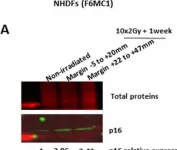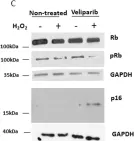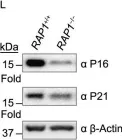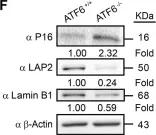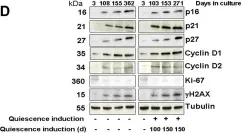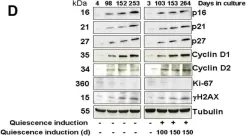Dysfunction of the ribosome manifests during cellular senescence and contributes to tissue aging, functional decline, and development of aging-related disorders in ways that have remained enigmatic. Here, we conducted a comprehensive CRISPR-based loss-of-function (LOF) screen of ribosome-associated genes (RAGs) in human mesenchymal progenitor cells (hMPCs). Through this approach, we identified ribosomal protein L22 (RPL22) as the foremost RAG whose deficiency mitigates the effects of cellular senescence. Consequently, absence of RPL22 delays hMPCs from becoming senescent, while an excess of RPL22 accelerates the senescence process. Mechanistically, we found in senescent hMPCs, RPL22 accumulates within the nucleolus. This accumulation triggers a cascade of events, including heterochromatin decompaction with concomitant degradation of key heterochromatin proteins, specifically heterochromatin protein 1γ (HP1γ) and heterochromatin protein KRAB-associated protein 1 (KAP1). Subsequently, RPL22-dependent breakdown of heterochromatin stimulates the transcription of ribosomal RNAs (rRNAs), triggering cellular senescence. In summary, our findings unveil a novel role for nucleolar RPL22 as a destabilizer of heterochromatin and a driver of cellular senescence, shedding new light on the intricate mechanisms underlying the aging process.
© The Author(s) 2024. Published by Oxford University Press on behalf of Nucleic Acids Research.
Product Citations: 107
CRISPR screening uncovers nucleolar RPL22 as a heterochromatin destabilizer and senescence driver.
In Nucleic Acids Research on 28 October 2024 by Li, H. Y., Wang, M., et al.
-
WB
-
Biochemistry and Molecular biology
Preprint on BioRxiv : the Preprint Server for Biology on 31 July 2024 by Khan, T., McFall, D. J., et al.
Current therapies for the epilepsies only treat the symptoms, but do not prevent epileptogenesis (the process in which epilepsy develops). Many cellular responses during epileptogenesis are also common hallmarks of cellular senescence , which halts proliferation of damaged cells. Clearing senescent cells (SCs) restores function in several age-associated and neurodegenerative disease models. It is unknown whether SC accumulation contributes to epileptogenesis and associated cognitive impairments. To address this question, we used a mouse model of temporal lobe epilepsy (TLE) and characterized the senescence phenotype throughout epileptogenesis. SCs accumulated 2 weeks after SE and were predominantly microglia. We ablated SCs and reduced (and in some cases prevented) the emergence of spontaneous seizures and normalized cognitive function in mice. Suggesting that this is a translationally-relevant target we also found SC accumulation in resected hippocampi from patients with TLE. These findings indicate that SC ablation after an epileptogenic insult is a potential anti-epileptogenic therapy.
SARS-CoV-2 S Protein Reduces Cytoprotective Defenses and Promotes Human Endothelial Cell Senescence.
In Aging and Disease on 25 June 2024 by Villacampa, A., Shamoon, L., et al.
Premature vascular aging and endothelial cell senescence are major risk factors for cardiovascular diseases and atherothrombotic disturbances, which are main complications of both acute and long COVID-19. The S protein of SARS-CoV2, which acts as the receptor binding protein for the viral infection, is able to induce endothelial cells inflammation and it has been found as an isolated element in the circulation and in human tissues reservoirs months after infection. Here, we investigated whether the S protein is able to directly induce endothelial cell senescence and deciphered some of the mechanisms involved. In primary cultures of human umbilical vein endothelial cells (HUVEC), SARS-CoV-2 S protein enhanced in a concentration-dependent manner the cellular content of senescence and DNA damage response markers (senescence-associated-β galactosidase, γH2AX), as well as growth-arrest effectors (p53, p21, p16). In parallel, the S protein reduced the availability of cytoprotective proteins, such as the anti-aging protein klotho, Nrf2 or heme oxygenase-1, and caused functional harm by impairing ex vivo endothelial-dependent vasorelaxation in murine microvessels. These effects were prevented by the pharmacological inhibition of the NLRP3 inflammasome with MCC950. Furthermore, the supplementation with either recombinant klotho or angiotensin-(1-7), equally protected against the pro-senescence, pro-inflammatory and pro-oxidant action of the S protein. Globally, this study proposes novel mechanisms of disease in the context of COVID-19 and its vascular sequelae and provides pharmacological clues in order to prevent such complications.
-
COVID-19
In Protein Cell on 28 May 2024 by Liu, F., Lu, Y., et al.
The synovium, a thin layer of tissue that is adjacent to the joints and secretes synovial fluid, undergoes changes in aging that contribute to intense shoulder pain and other joint diseases. However, the mechanism underlying human synovial aging remains poorly characterized. Here, we generated a comprehensive transcriptomic profile of synovial cells present in the subacromial synovium from young and aged individuals. By delineating aging-related transcriptomic changes across different cell types and their associated regulatory networks, we identified two subsets of mesenchymal stromal cells (MSCs) in human synovium, which are lining and sublining MSCs, and found that angiogenesis and fibrosis-associated genes were upregulated whereas genes associated with cell adhesion and cartilage development were downregulated in aged MSCs. Moreover, the specific cell-cell communications in aged synovium mirrors that of aging-related inflammation and tissue remodeling, including vascular hyperplasia and tissue fibrosis. In particular, we identified forkhead box O1 (FOXO1) as one of the major regulons for aging differentially expressed genes (DEGs) in synovial MSCs, and validated its downregulation in both lining and sublining MSC populations of the aged synovium. In human FOXO1-depleted MSCs derived from human embryonic stem cells, we recapitulated the senescent phenotype observed in the subacromial synovium of aged donors. These data indicate an important role of FOXO1 in the regulation of human synovial aging. Overall, our study improves our understanding of synovial aging during joint degeneration, thereby informing the development of novel intervention strategies aimed at rejuvenating the aged joint.
© The Author(s) 2023. Published by Oxford University Press on behalf of Higher Education Press.
Reducing oxidative protein folding alleviates senescence by minimizing ER-to-nucleus H2 O2 release.
In EMBO Reports on 3 August 2023 by Cheng, F., Ji, Q., et al.
Oxidative protein folding occurs in the endoplasmic reticulum (ER) to generate disulfide bonds, and the by-product is hydrogen peroxide (H2 O2 ). However, the relationship between oxidative protein folding and senescence remains uncharacterized. Here, we find that the protein disulfide isomerase (PDI), a key oxidoreductase that catalyzes oxidative protein folding, accumulated in aged human mesenchymal stem cells (hMSCs) and deletion of PDI alleviated hMSCs senescence. Mechanistically, knocking out PDI slows the rate of oxidative protein folding and decreases the leakage of ER-derived H2 O2 into the nucleus, thereby decreasing the expression of SERPINE1, which was identified as a key driver of cell senescence. Furthermore, we show that depletion of PDI alleviated senescence in various cell models of aging. Our findings reveal a previously unrecognized role of oxidative protein folding in promoting cell aging, providing a potential target for aging and aging-related disease intervention.
© 2023 The Authors.
-
WB
In Elife on 18 March 2022 by Goy, E., Tomezak, M., et al.
Fig.2.A

-
WB
-
Collected and cropped from Elife by CiteAb, provided under a CC-BY license
Image 1 of 7
In Elife on 18 March 2022 by Goy, E., Tomezak, M., et al.
Fig.7.C

-
WB
-
Collected and cropped from Elife by CiteAb, provided under a CC-BY license
Image 1 of 7
In Protein Cell on 1 September 2019 by Zhang, X., Liu, Z., et al.
Fig.2.L

-
WB
-
Homo sapiens (Human)
Collected and cropped from Protein Cell by CiteAb, provided under a CC-BY license
Image 1 of 7
In Cell Discov on 10 February 2018 by Wang, S., Hu, B., et al.
Fig.2.F

-
WB
-
Homo sapiens (Human)
Collected and cropped from Cell Discov by CiteAb, provided under a CC-BY license
Image 1 of 7
In PLoS One on 4 May 2016 by Marthandan, S., Baumgart, M., et al.
Fig.6.B

-
WB
-
Collected and cropped from PLoS One by CiteAb, provided under a CC-BY license
Image 1 of 7
In PLoS One on 23 December 2014 by Marthandan, S., Priebe, S., et al.
Fig.3.D

-
WB
-
Homo sapiens (Human)
Collected and cropped from PLoS One by CiteAb, provided under a CC-BY license
Image 1 of 7
In PLoS One on 23 December 2014 by Marthandan, S., Priebe, S., et al.
Fig.2.D

-
WB
-
Homo sapiens (Human)
Collected and cropped from PLoS One by CiteAb, provided under a CC-BY license
Image 1 of 7
